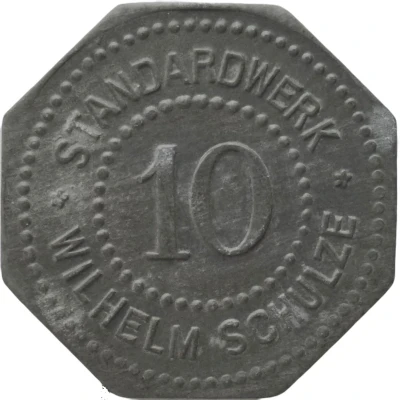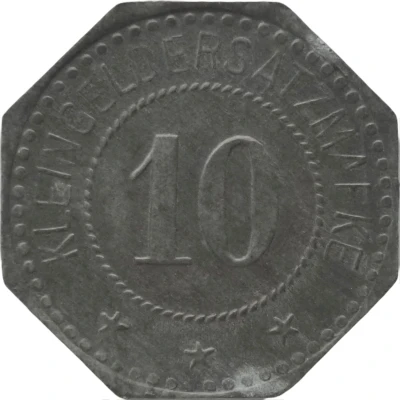


© Willem63 (CC BY-NC-SA)
10 Pfennigs - Hannover (Standardwerk Wilhelm Schulze) ND
| Zinc | 2.1 g | 20.8 mm |
| Issuer | Prussian province of Hanover (German notgeld) |
|---|---|
| Type | Standard circulation coin |
| Value | 10 Pfennigs (10 Pfennige) (0.10) |
| Currency | Mark (1914-1924) |
| Composition | Zinc |
| Weight | 2.1 g |
| Diameter | 20.8 mm |
| Thickness | 1.1 mm |
| Shape | Octagonal (8-sided) |
| Technique | Milled |
| Orientation | Medal alignment ↑↑ |
| Demonetized | Yes |
| Updated | 2024-10-04 |
| Numista | N#339139 |
|---|---|
| Rarity index | 97% |
Reverse
Pearl rim, legend surrounding rope circle with denomination centered
Script: Latin
Lettering:
KLEINGELDERSATZMARKE
10
★ ★ ★
Edge
Plain
Comment
Menzel: BBBFa: Landmaschinenfabrik
Interesting fact
One interesting fact about the 10 Pfennigs - Hannover (Standardwerk Wilhelm Schulze) ND coin is that it was made of zinc, which was a unusual material for coins at that time. Most coins were made of metals like copper, silver, or gold, but the use of zinc in this coin reflects the economic and political circumstances of the time. The Prussian province of Hanover, where the coin was issued, was experiencing economic difficulties and zinc was a cheaper alternative to other metals. This coin is a unique example of how economic pressures can shape the design and composition of currency.